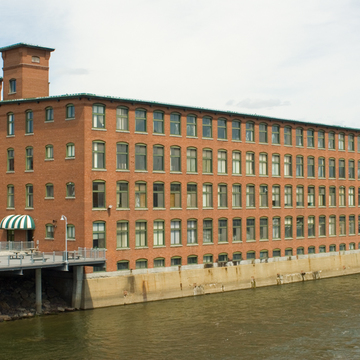In 1909 the American Woolen Company, which had purchased the Burlington Woolen Company mills in the 1890s, decided to construct a modern textile mill by the Winooski River falls, whose waterpower had been harnessed for cloth manufacture since 1837. Plans were formulated by the company's general agent, George E. Whitney, and the project's contractor, E. W. Pitman, who came to Vermont from the mill town of Lawrence, Massachusetts. They began by demolishing several existing mills to clear a site that was large enough to accommodate a 100 × 280– foot brick mill, rising five stories from the riverbank with large segmental-arched windows, a corner stair tower, an elevator tower, and a clerestory above the flat roof. The mill was powered by a water turbine drawing water from the upper falls and a steam turbine, both located in the powerhouse at the east end of the mill. In its first year of operation, children as well as adults worked in the mill until Vermont outlawed child labor in 1913. Although a modern industrial building in its day, the structure represents the final iteration of the vertical, multistory, high-density textile mill that emerged in England in the late eighteenth century.
American Woolen closed its Winooski operations in 1954. For most of the next four decades, the mill was leased for industrial use and storage and became increasingly derelict. In the 1990s local developer Raymond Pecor rehabilitated the mill for retail space, winning accolades from preservationists by retaining many of the buildings's original exposed industrial finishes, a departure from earlier mill conversions. The mill continues to play a key role in Winooski's current redevelopment efforts.





















